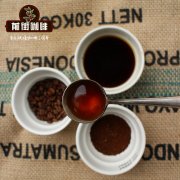How to distinguish Arabica coffee beans by their appearance

Professional coffee knowledge exchange more coffee bean information please follow the coffee workshop (Wechat official account cafe_style)
Qianjie-Arabica variety introduction
Arabica, (scientific name Coffee arabica, Coffee Arabica), also known as Arabica coffee, is a native species of coffee grown on the Abyssinia Plateau of Ethiopia (present-day Ethiopian Plateau). According to textual research, it is the first artificially cultivated coffee variety in the world, one of the most important coffee tree species, accounting for 70% of the global coffee consumption. This kind of beverage has been cultivated in southwest Arabia for more than 1000 years. It was introduced into Europe through the Arab world in the 16th century and became a favorite drink all over the world.
[Arabica Coffee Tree]
The Arabica coffee tree, which originated in Ethiopia, accounts for 70% of the world's coffee bean production. The world-famous blue mountain caffeine and mocha coffee are almost all Arabica species. Arabica coffee trees are suitable for growing in high mountains with large temperature difference between day and night, and ten soils with low humidity and good drainage; the ideal altitude is 500m ~ 2000 m, and the higher the altitude is, the better the quality is. However, due to the weak ability to resist diseases and insect pests, it is more difficult to grow than the other two coffee trees.
Features: relatively cold-resistant, suitable for growth temperature of 15-24 degrees
[Arabica coffee beans]
Arabica, also known as small coffee beans, is native to Ethiopia. Coffee planting conditions are more stringent, disease resistance is weak, higher altitude requirements, slower growth, higher quality, raw bean treatment is more refined.
Arabica Coffee Tree is a large shrub with coconut-shaped leaves and dark green leaves and coconut-shaped fruit. Generally, there are two slightly flat beans with long coconut shape on the front, narrow and curved cracks in the middle, S-shaped, and a flat arc on the back of the beans. Caffeine content is about 0.8% Rue 1.5%.
It grows at colder high altitudes in the tropics and is an important kind of commercial coffee with a fruiting period of less than three years and a high-quality aroma and sour taste. Arabica coffee beans are of Ethiopian origin, mainly in South America (except parts of Argentina and Brazil), Central America, Africa (Kenya, Ethiopia, etc.), mainly East African countries, Asia (parts of Yemen, India and Papua New Guinea)
[flavor characteristics]
In terms of composition alone, Arabica coffee has a low caffeine content, ranging from 0.9% to 1.2%, and is rich in fat and sugar, so it has a soft, non-irritating, fresh and sweet taste; it has a varied and broad potential flavor. Arabica coffee produced in different regions, different elevations and different climates usually has its own characteristics and can show a completely different flavor. "Arabica" coffee smells like grass when it is not roasted. After proper roasting, it shows "fruity" (medium to shallow roasting) and "caramel sweetness" (deep roasting).
Arabica variety family: Ethiopian native species, Typica, Bourbon, Kaddura (Catura), Pacas (Pacas), Vera Saatchi (Villa Sarchi), elephant bean (Maragogype), Pakamara (Pacamara), New World (Mundo Novo), Kaduai (Catuai), Rosa (Geisha), Timor (Timor), Katim (Catimor)
Knowledge: Robusta is planted below 800 meters above sea level. Robusta has strong adaptability and strong resistance to diseases and insect pests.
In short: Qianjie is a coffee research hall, happy to share the knowledge about coffee with you, we share unreservedly just to make more friends fall in love with coffee, and there will be three low-discount coffee activities every month. The reason is that Qianjie wants to make more friends drink the best coffee at the lowest price, which has been Qianjie's tenet for 6 years!
END
Important Notice :
前街咖啡 FrontStreet Coffee has moved to new addredd:
FrontStreet Coffee Address: 315,Donghua East Road,GuangZhou
Tel:020 38364473
- Prev

How about Arabica coffee beans? the petite girls of Arabica coffee beans
Professional coffee knowledge exchange more coffee bean information please pay attention to the coffee workshop (Wechat official account cafe_style) front street-Arabica variety introduction in many media advertising, often appear 100% Arabica such words, which also led to a lot of onlookers who do not know the truth, think that Arabica = high-quality coffee, which has become a difference between many coffee practitioners over the years
- Next

The type of coffee beans is one of the most famous high-quality Arabica coffee beans indispensable conditions
Professional coffee knowledge exchange More coffee bean information Please pay attention to coffee workshop (Weixin Official Accounts cafe_style) Front Street-Arabica Variety Introduction Arabica coffee planting conditions are more stringent, requiring higher altitude (600 to 2000 meters above sea level), fertile soil, sufficient moisture, appropriate sunshine conditions and shade, Arabica
Related
- Beginners will see the "Coffee pull flower" guide!
- What is the difference between ice blog purified milk and ordinary milk coffee?
- Why is the Philippines the largest producer of crops in Liberia?
- For coffee extraction, should the fine powder be retained?
- How does extracted espresso fill pressed powder? How much strength does it take to press the powder?
- How to make jasmine cold extract coffee? Is the jasmine + latte good?
- Will this little toy really make the coffee taste better? How does Lily Drip affect coffee extraction?
- Will the action of slapping the filter cup also affect coffee extraction?
- What's the difference between powder-to-water ratio and powder-to-liquid ratio?
- What is the Ethiopian local species? What does it have to do with Heirloom native species?

